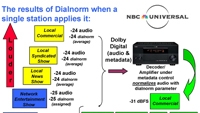NBCU urges industry to adopt dialnorm for DTV audio

Are you tired of having to reach for the volume control when watching TV? In an effort to bring the best audio experience to audiences and advertisers, the NBC Universal Television Stations Group has begun to implement a companywide procedure that helps station engineers establish and maintain proper station loudness levels for their digital TV broadcasts.
The new initiative is based around a concept called dialog normalization, or "dialnorm," that uses digital metadata that accompanies the transmitted audio. Dialnorm is identified in the ATSC standard adopted by the FCC for DTV in 1996 that’s used for all digital TV in the United States.
NBCU has embraced the ATSC dialnorm practice and is trying to get the rest of the industry on board. Right now, dialog levels on HDTV channels vary within channels and between channels, causing viewers to have to repeatedly adjust volume. With dialnorm, dialog levels will remain consistent.
Jim Starzynski, principal engineer of NBC-Universal Advanced Technology, said that practices for managing loudness for digital television are drastically improved over those of the existing NTSC analog system, so there’s no reason why the industry can’t get it right and adopt the ATSC dialnorm practice.
Studies have indicated that audiences adjust their volume controls to the sound of the spoken word within a program. Proper dialnorm practices require that a unique and accurate loudness data parameter be transmitted from the DTV station to the home. This figure needs to match the level of the average spoken dialog within the encoded audio program for dialnorm to work as intended.
As part of a company rollout, NBCU station engineers will accomplish this by taking measurements of all local SD programming throughout the broadcast day. This study will yield a number (e.g. –24dBFS) that will be set at each station’s encoder, representing the average of their audio dialog level.
Starzynski said this would automatically adjust the local station audio to the same level as the NBCU network, which has been using dialnorm since 2004. If implemented universally, this will also match the audio level of any station. All of this happens without impacting the dynamic range of the sound and eliminates the need for the viewer to reach for the volume control during program to commercial transitions and channel changes.
The professional video industry's #1 source for news, trends and product and tech information. Sign up below.
Starzynski said the process for adjusting SD material was easy. A station engineer simply determines the average amplitude of the station’s dialog with a loudness meter (such as a Dolby LM-100, or any meter using the Leq(A) standard of measurement for dialog). NBCU stations that don’t already have a meter will be able to use available units that will be shared across the station group. Once the dialnorm number is determined, it’s a one-time entry into the station’s DTV audio encoder’s preset.
As station content moves to HD, the system becomes even more powerful. Averaging the amplitude will be supplanted by dynamic dialnorm that uniquely matches each program and spot, delivered to the home exactly as the program provider intended.
